
This article is about the postage stamps and postal history of Hamburg from the medieval messengers until the entry of the Hamburg Postal Administration into the Northern German Postal District in 1868.

This article is about the postage stamps and postal history of Hamburg from the medieval messengers until the entry of the Hamburg Postal Administration into the Northern German Postal District in 1868.
| History of Hamburg |
|---|
 |
| by timeline |
| by other topic |
|
After the foundation of the German Hanseatic League in the late Middle Ages, so-called regulated messenger hauls were formed, which were used to transport messages from Hamburg via Lübeck, Rostock, Stettin, Danzig, and Königsberg to Riga, as well as via Bremen to Amsterdam and via Celle and Braunschweig to Nuremberg.
In 1649, a Danish post office opened in Hamburg. In the 17th century, the Thurn und Taxis post settled down in Hamburg; the post and goods carriage, with royal privileges, was established between Hamburg and Nuremberg.
In 1810, Napoleon annexed the three Hanseatic cities and the northwest of Germany in the course of the Continental System against Great Britain.
After the end of the French occupation, several post offices were re-established in Hamburg. The Hanseatic city had its own post offices in Hamburg and Ritzebüttel. In the Hamburg city post office (Mengstraße No. 43), the Swedish-Norwegian post, the post of Thurn and Taxis (Mengstraße No. 48), and the post of Hannover were housed. The Prussian Central Post Office, the Mecklenburg Post, and the Danish Post worked in their own buildings.
A register was available where one could look up where to hand over his post for different destinations. The post to England and overseas was delivered by the city post. The Thurn und Taxis post was in charge of the post to France, Spain, Portugal, Italy, Belgium, and Switzerland. Prussia delivered the post to Russia and Poland, as well as to Turkey via Austria. Scandinavia was supplied by the Danish or the Swedish-Norwegian post.
Starting in 1796, the post to Heligoland, which belonged to Denmark at that time, was delivered by a Hamburg postal agent, as there was a Hamburg postal agency on Heligoland.
On 1 January 1852, Hamburg joined the German-Austrian Postal Union. Since 1866, Hamburg was part of the North German Confederation, which took over the postal service in the North German Postal District on 1 January 1868.

The first postage stamps of the Hamburg City Post Office were introduced on 1 January 1859. They were rectangular and in the middle was the coat of arms of the city, overlaid with the value number. Below that is the word Postmarke (postage stamp), above it is Hamburg. Value and currency ( Schilling ) are imprinted as text at the borders. Values of ½, 1, 2, 3, 4, 7, and 9 Schillinge were issued. In 1864, the supplemental values 1.25 and 2.5 Schillinge with a different frame design were issued. These early issues were already gummed but still imperforated. The following nine values, issued in 1864 and 1867 and again with the design of the first issues, finally had perforations. In 1866, another two values with a different octagonal frame design were issued; and on 5 May 1867, another one with the design of the first stamps. Hamburg's stamps were only valid until the end of 1867, since as of 1 January 1868, only the stamps of the North German Postal District were valid.
The Institute of Hamburg's Messengers issued a stamp with the value of ½ Schilling. The private company delivered only letters and newspapers within the city of Hamburg and charged half a Schilling. The stamps were printed in black on coloured paper.
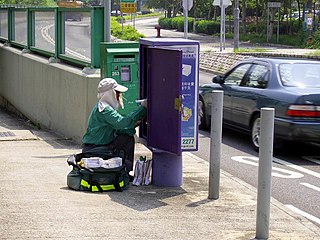
The mail or post is a system for physically transporting postcards, letters, and parcels. A postal service can be private or public, though many governments place restrictions on private systems. Since the mid-19th century, national postal systems have generally been established as a government monopoly, with a fee on the article prepaid. Proof of payment is usually in the form of an adhesive postage stamp, but a postage meter is also used for bulk mailing.

The Princely House of Thurn and Taxis is a family of German nobility that is part of the Briefadel. It was a key player in the postal services in Europe during the 16th century, until the end of the Holy Roman Empire in 1806, and became well known as the owner of breweries and commissioner of several castles. The family has resided in Regensburg since 1748 with their seat at St. Emmeram Castle from 1803. The family is one of the wealthiest in Germany, and the current head of the House is Albert, 12th Prince of Thurn and Taxis.
This is a partial timeline of significant events in postal history, including dates and events relating to postage stamps.
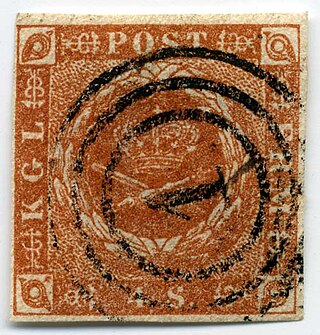
This is an overview of the postage stamps and postal history of Denmark.
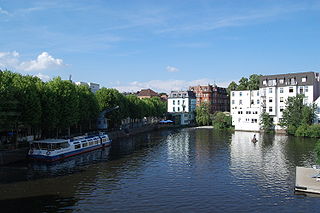
Bergedorf is the largest of the seven boroughs of Hamburg, Germany, named after Bergedorf quarter within this borough. In 2020 the population of the borough was 130,994.

One of the functions of the North German Confederation was to handle the mail and issue postage stamps, which it began doing, by means of the North German Postal Union (Norddeutscher Postbezirk), on 1 January 1868.
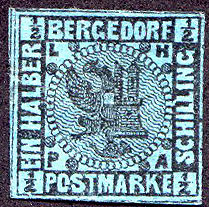
Bergedorf's postal authority issued only five stamps between 1861 and 1867. Bergedorf is the smallest field of German stamp collecting.
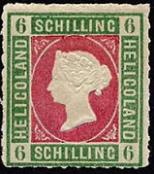
During the period when Heligoland was a British possession, about 20 postage stamps were issued between 1867 and 1890. There were up to eight printings of a single denomination and also a large volume of reprints which are known as the Berlin, Leipzig and Hamburg Reprints, respectively. The Berlin reprints are sometimes better quality than the originals. The reprints were done between 1875 and 1895. Consequently, many "old" collections contain reprints rather than originals. Some believe there were seven million reprints as compared to the known 1½ million originals, of which perhaps half were sold through the post office and the remainder sold to dealers when withdrawn from use. A few printings were never postally sold but nevertheless found their way into the hands of dealers. The stamps were printed by the Prussian State Printing Office in Berlin. They were denominated in the Hamburg Schilling until 1875, when both German Reich and British values appeared on each stamp issue. All are embossed with a silhouette of Queen Victoria excepting the four highest values which represent Heligoland escutcheons.

Soon after the German Hanseatic League (1241) was founded, regulated messenger routes were developed. In the Free Imperial City of Lübeck, the conveyance of correspondence by letter was supervised by the mercantile council of the Scania Market (Schonenfahrer), which also appointed the messenger master (postmaster) and the remainder of the personnel.
Postage stamps and postal history of Baden refers to the postal history and postage stamps of the German state of Baden from 1851 to 1871.
The Austro-German Postal Union was a union of the postal systems of the Austrian Empire and the pre-Empire German states. The union was established on 1 July 1850. The administrative prerequisites were already provided by the German Zollverein established in 1834. On 18 October 1847 the representatives convened to the German Postal Conference in Dresden on a suggestion of Prussia and Austria. Not until 6 April 1850, Prussia and Austria, slowed by political circumstances, closed a contract establishing a German–Austrian Postal Association in Berlin.

By the Hamburg Agreement on 8 March 1701, Mecklenburg was separated into two duchies with limited autonomy, which formed a collective state–as of 1815, the Grand Duchies of Mecklenburg-Schwerin and Mecklenburg-Strelitz. Since 1755, they had the same constitution and were under the control of the same parliament. In 1815, both parts became Grand Duchies by the Congress of Vienna.
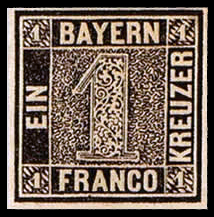
This is a survey of the postage stamps and postal history of Germany and philatelically related areas. The main modern providers of service were the Reichspost (1871–1945), the Deutsche Post under Allied control (1945–1949), the Deutsche Post of the GDR (1949–1990), the Deutsche Bundespost (1949–1995), along with the Deutsche Bundespost Berlin (1949–1990), and are now the Deutsche Post AG.

Postal history in the territory that now constitutes Latvia began during the 13th century, when the Archbishopric of Riga was included to the area of postal operations of the Monastic state of the Teutonic Knights and the Hanseatic League. In 1580 the Hanseatic League issued their first known regulations on courier work and payroll, regulations that also were active in the territory that now constitutes Latvia.

Maximilian Karl, 6th Prince of Thurn and Taxis, full German name: Maximilian Karl Fürst von Thurn und Taxis was the sixth Prince of Thurn and Taxis, head of the Thurn-und-Taxis-Post, and Head of the Princely House of Thurn and Taxis from 15 July 1827 until his death on 10 November 1871.
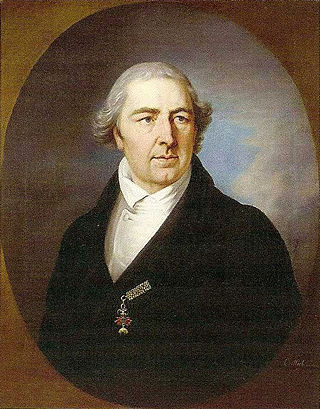
Karl Alexander, 5th Prince of Thurn and Taxis, full German name: Karl Alexander Fürst von Thurn und Taxis was the fifth Prince of Thurn and Taxis, head of the Thurn-und-Taxis-Post, and Head of the Princely House of Thurn and Taxis from 13 November 1805 until his death on 15 July 1827. With the death of his father on 13 November 1805, he became nominal Generalpostmeister of the Imperial Reichspost until the resignation of Francis II, Holy Roman Emperor.

The postal history of Hungary is strongly linked to the history of Hungary. While a messenger system was brought to the Carpathian Basin by Árpád as early as 895, modern mail delivery was first organized by the Habsburgs under the Austrian Empire.
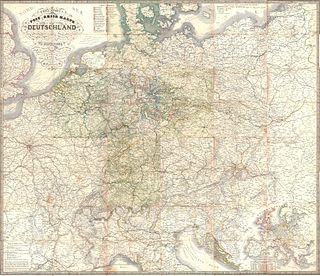
The Thurn-und-Taxis Post was a private postal service and the successor to the Imperial Reichspost of the Holy Roman Empire. The Thurn-und-Taxis Post was operated by the Princely House of Thurn and Taxis between 1806 and 1867. The company was headquartered in Regensburg from its creation in 1806 until 1810 when it relocated to Frankfurt am Main where it remained until 1867.
This is a survey of the postage stamps and postal history of Holstein, Schleswig-Holstein, Schleswig and incidentally Lauenberg. Separate stamps were issued for Holstein (1850), Schleswig (1864-1867), Holstein (1864-1866), Schleswig-Holstein (1865) and Schleswig (1920).